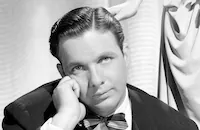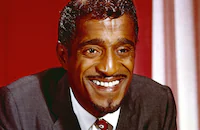Jazz Ball
Brief Synopsis
Cast & Crew
Art Gilmore
Bob Crosby
Sammy Davis Jr.
Jimmy Dorsey
Ina Rae Hutton
Red Nichols
Film Details
Technical Specs

Synopsis
The film is a compilation of performances by several small bands, orchestras and vocalists whose work depicts the wide variety of American jazz music ranging from blues, ragtime, scat, swing and jive to boogie-woogie. Jazz had its origins from the Basin Street "Dixieland" sound in New Orleans to Chicago saloons and New York's Harlem nightclubs and is based on innovation and improvisation:
Cab Calloway, also known as "Mr. Hi-De-Ho" for popularizing the tune "Hi-De-Ho," got his start at New York's famous Harlem Cotton Club. His enthusiastic dancing and singing was known as "jive" and he was one of the first vocalists to popularize "scat," a wordless improvisational singing. Some of the most famous soloists in Calloway's orchestra included Dizzy Gillespie and Milt Hinton, who went on to have their own solo or orchestral careers.
Crooner Rudy Vallee, later known as "The Vagabond Lover" on his popular radio show, overcame jokes about his straightlaced New England background by adopting a distinctive, mellow vocal delivery. It is not as well known that just after leaving Yale, Vallee headed a small band called The Yankees in which he played saxophone and clarinet. The Yankees became popular in several New York clubs.
Duke Ellington is known as the greatest single contributor to jazz in the capacity of composer, arranger and pianist. Born in Washington, D.C., Ellington was influenced by ragtime and made his professional debut at the age of seventeen in 1916. Later, at the recommendation of jazz pianist "Fats" Waller, Ellington moved to New York City in the early 1920s, and by the end of the decade was headlining at Harlem's Cotton Club. Ellington would train many future jazz greats including Sonny Greer, Billy Strayhorn, Earl Hines and Johnny Hodges. Ellington frequently highlighted syncopated dance, a displacement or shifting of the usual metric beat, by using tap dancers during numbers, including Florence Hill and Bessie Dudley.
Smooth vocalists The Mills Brothers were originally made up of brothers Herbert, Harry, Donald and John Jr. until John's death in 1936 when he was replaced by John, Sr. The Mills Brothers specialized in a capella harmony singing and in imitating the sound of various instruments.
Other musicians who were influenced by "Dixieland" and "scat" styles were trombonist Russ Morgan and trumpeter and early scat singer Louis Prima as well as Red Nichols, a trumpeter and band leader whose sidemen were called The Five Pennies. One of the few female jazz bands of the period was led by vocalist and "hoofer" Ina Rae Hutton. Louis "Satchmo" Armstrong shared the spotlight with Duke Ellington as one of jazz's greatest influences, a trumpeter who fused Dixieland styles and Chicago jazz.
Dixieland and scat jazz gave way to swing and one of the earliest bands was Bob Crosby and his Bobcats. The younger brother of singer Bing Crosby, Bob began with trombonist Tommy Dorsey's band then formed his own band in which he also served as vocalist. Another popular vocalist was singer and later film star Betty Hutton, who recorded and performed early on with Vincent Lopez and his swing band. A softer style was presented by singer Peggy Lee, who reached early fame while working with the "King of Swing," clarinetist Benny Goodman.
Swing applied the spirit of jazz improvisation to classical music. Composer Isham Jones, writer of "It Had to Be You" and "I'll See You in My Dreams," was one of many bandleaders who looked to the classics for a little fun and recorded a lively version of Lizst's "Hungarian Rhapsody No. 2."
A variant of jazz swing was "boogie-woogie," enthusiastically popularized by orchestras such as those led by saxophone player Bob Chester, Hal Kemp, sax and clarinetist Jimmy Dorsey and drummer Gene Krupa, who also reached fame playing with Goodman and his quartet. Even stalwart polka master Lawrence Welk recorded a few songs with the lively boogie-woogie beat.
Chicago's Benny Goodman got the most serious competition from Artie Shaw, the clarinet player, composer, orchestra leader and arranger who expanded boogie-woogie and swing with compositions influenced by Latin rhythms. Among the many soloists Shaw helped launch was drummer Buddy Rich.

Cast
Art Gilmore

Bob Crosby

Sammy Davis Jr.
Jimmy Dorsey
Ina Rae Hutton
Red Nichols
Russ Morgan
Isham Jones
Hal Kemp
Henry Busse
The Mills Brothers
Gene Krupa

Peggy Lee
Louis Prima

Artie Shaw
Buddy Rich
Johnny "scat" Davis
Bob Chester
Lawrence Welk
Vincent Lopez

Betty Hutton

Cab Calloway

Rudy Vallee And His Connecticut Yankees

Duke Ellington
Florence Hill
Bessie Dudley

Louis Armstrong
Will Mastin Trio
Bill Darnell
Dave Barbour And His Music Sequence
Clyde Lucas And His Orchestra
Modern Mountaineers
Paul Whiteman's Band
The Bobcats
Crew
Milton Ager
Harold Arlen
Gene Austin
David Barbour
Ray Bauduc
Rube Bloom
Herbert L. Bregstein
Lew Brown
Henry Busse
Cab Calloway
Harry Carney
Everett Carter
Bob Chester
Larry Clinton
Phil Cohen
Sam Coslow
Ford Dabney
Lou Davis
Jimmy Dorsey
Duke Ellington
Alvin Ganzer
Roger Graham
Bob Haggart
Jim Hanaghan
Justin Herman
Ving Hershon
Milton Hocky
Jerry Hopper
William Jerome
Arthur Johnston
Ray Jordan
Hal Kemp
Ted Koehler
Ray Krise
Burton Lane
Henry Lange
Peggy Lee
Charles Leonard
Franz Liszt
Frank Loesser
Cecil Mack
Fred Meinken
Billy Meyers
Irving Mills
Herbert Moulton
Jack Pettis
David Peyton
David Ringle
Jack Roberts
Milton Rosen
Fred Roth
Leslie Roush
Joe Santley
Elmer Schoebel
Jean Schwartz
Aubrey Scotto
Artie Shaw
Fred Waller
Harry White
Chappie Willett
Spencer Williams
Allie Wrubel
Jack Yellen

Film Details
Technical Specs

Quotes
Trivia
Notes
Rudy Vallee's onscreen credit reads "Rudy Vallee and His Connecticut Yankees." The film is a compilation of footage from various musical shorts produced by Paramount in the 1930s and 1940s. Each segment illustrates a different type of jazz performance and the segments are loosely held together by a new offscreen narration by Art Gilmore. Modern sources add Ray Bauduc, Bob Eberle, Tony Pastor, Charlie Spivak, Billie Butterfield and Roy Eldridge to the cast. No production company was listed on the viewed print, which only credits NTA Pictures, Inc., a company that normally distributed re-issued films.












